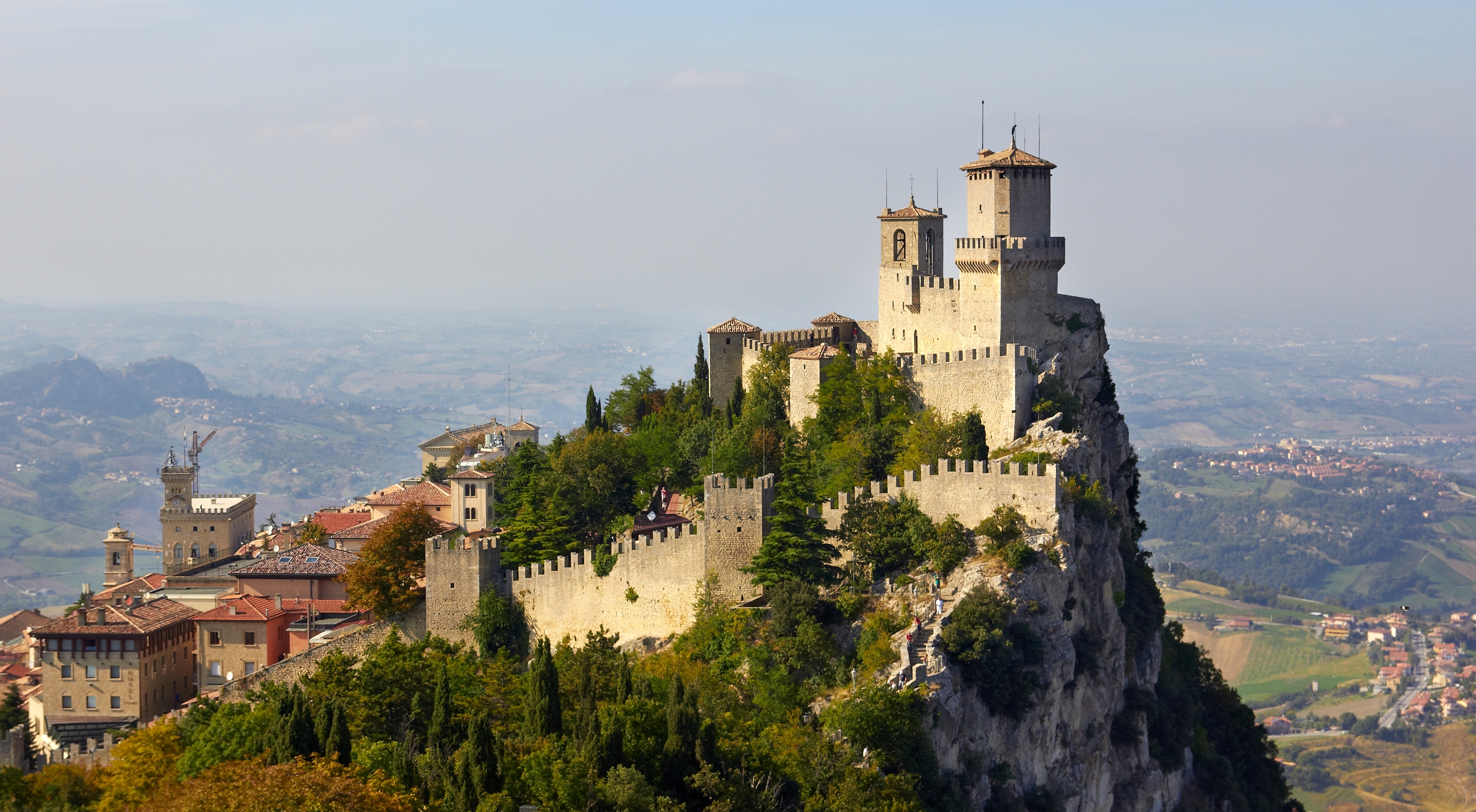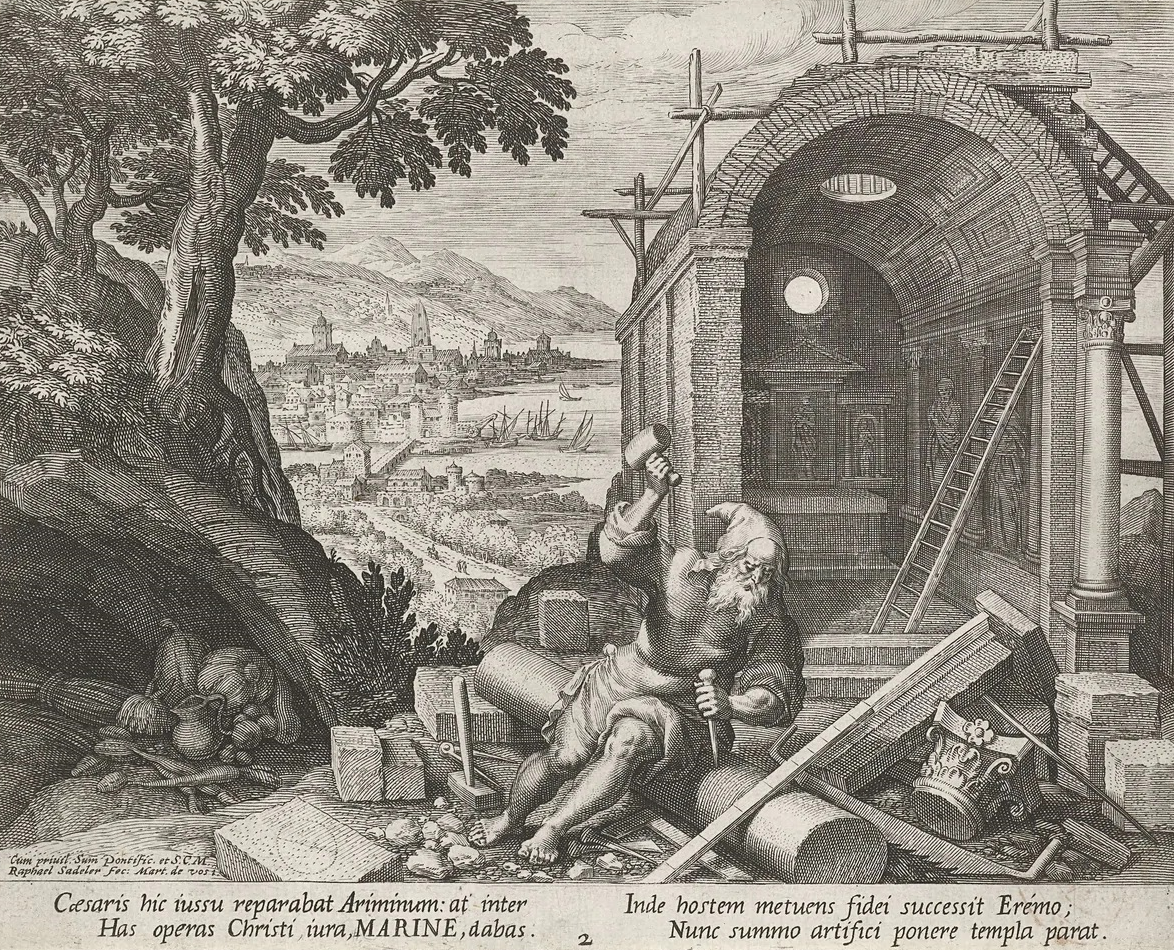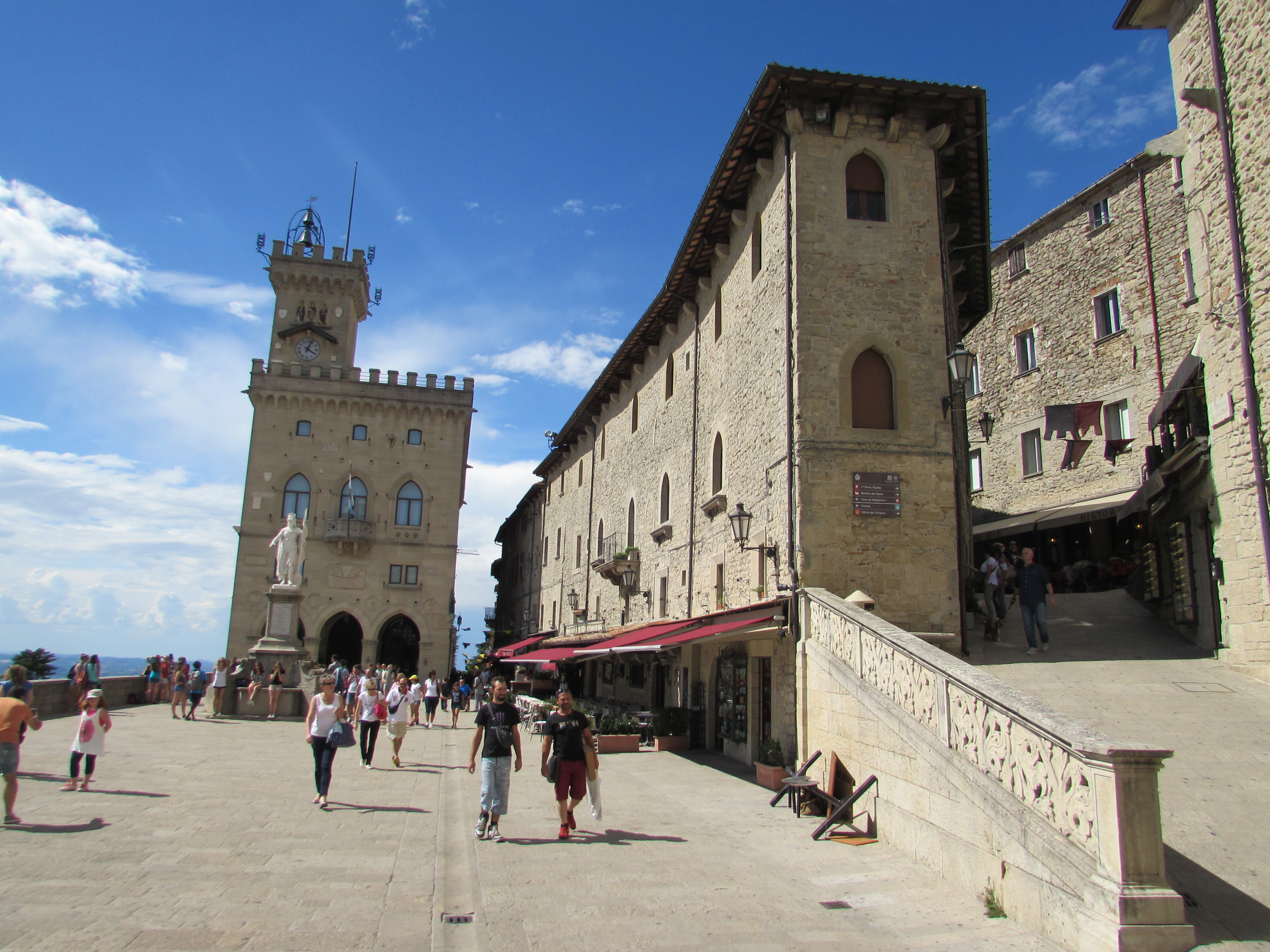|
Tourism In San Marino
Tourism in San Marino, known also as the Most Serene Republic of San Marino (Italian: Serenissima Repubblica di San Marino) is an integral element of the economy within the microstate. The tourism sector contributes a large part of San Marino's GDP, with approximately 2 million tourists visiting per year. Tourism is among the republic's most important sectors due to its significant contribution to the GDP. The rate of tourists has increased in recent years, as visitors are drawn to the landscape, cuisine and architectural sights of the mountainous microstate. San Marino attracts approximately two million tourists a year, of which 1,822,000 derived from Europe in 2018. In comparison with other European microstates (Andorra, Malta, Monaco and Vatican City), as of 2018 San Marino attracts the fewest tourists. Geographically, San Marino is an independent microstate surrounded by the Italian Republic. The enclave state is situated in central Italy on the northeastern edge of the A ... [...More Info...] [...Related Items...] OR: [Wikipedia] [Google] [Baidu] |
San Marino
San Marino (, ), officially the Republic of San Marino ( it, Repubblica di San Marino; ), also known as the Most Serene Republic of San Marino ( it, Serenissima Repubblica di San Marino, links=no), is the fifth-smallest country in the world and a European microstate in Southern Europe enclaved by Italy. Located on the northeastern side of the Apennine Mountains, San Marino covers a land area of just over , and has a population of 33,562. San Marino is a landlocked country; however, its northeastern end is within of the Italian city of Rimini on the Adriatic coast. The nearest airport is also in Italy. The country's capital city, the City of San Marino, is located atop Monte Titano, while its largest settlement is Dogana within the largest municipality of Serravalle. San Marino's official language is Italian. The country derives its name from Saint Marinus, a stonemason from the then-Roman island of Rab in present-day Croatia. Born in AD 275, Marinus participated in the re ... [...More Info...] [...Related Items...] OR: [Wikipedia] [Google] [Baidu] |
City Of San Marino
The City of San Marino ( it, Città di San Marino; also known simply as San Marino and locally as Città) is the capital city of the Republic of San Marino. It has a population of 4,061. It is on the western slopes of San Marino's highest point, Monte Titano. Geography Although not the capital, most of the businesses are in Borgo Maggiore. It is the third largest city in the country, after Dogana and Borgo Maggiore. It borders the San Marino municipalities Acquaviva, Borgo Maggiore, Fiorentino, and Chiesanuova and the Italian municipality San Leo. Akademio Internacia de la Sciencoj San Marino was centered here. History ''Due to its being the capital and previously the only city in San Marino, the history of this city is almost the same as the History of San Marino. For more information on that topic, see that article.'' The city was founded by Saint Marinus and several Christian refugees in the year 301. From then on the city became a center of Christian refugees who f ... [...More Info...] [...Related Items...] OR: [Wikipedia] [Google] [Baidu] |
Neoclassical Architecture
Neoclassical architecture is an architectural style produced by the Neoclassical movement that began in the mid-18th century in Italy and France. It became one of the most prominent architectural styles in the Western world. The prevailing styles of architecture in most of Europe for the previous two centuries, Renaissance architecture and Baroque architecture, already represented partial revivals of the Classical architecture of ancient Rome and (much less) ancient Greek architecture, but the Neoclassical movement aimed to strip away the excesses of Late Baroque and return to a purer and more authentic classical style, adapted to modern purposes. The development of archaeology and published accurate records of surviving classical buildings was crucial in the emergence of Neoclassical architecture. In many countries, there was an initial wave essentially drawing on Roman architecture, followed, from about the start of the 19th century, by a second wave of Greek Revival architec ... [...More Info...] [...Related Items...] OR: [Wikipedia] [Google] [Baidu] |
Saint Marinus
Saint Marinus (; it, San Marino) was an Early Christian and the founder of a chapel and monastery in 301 from whose initial community the state of San Marino later grew. Life Tradition holds that he was a stonemason by trade who came from the island of Arba (today Rab), on the other side of the Adriatic Sea (in what is now part of modern-day Croatia, then part of the Roman Empire), fleeing persecution for his Christian beliefs in the Diocletianic Persecution. Known only by the single name ''Marinus'' (lit. of the sea), he became a Deacon, and was ordained by Gaudentius, the Bishop of Rimini; later, he was recognised and accused by an insane woman of being her estranged husband, so he quickly fled to Monte Titano to build a chapel-monastery and live as a hermit.Radovan Radovinovič, ''The Croatian Adriatic Tourist Guide'', pg. 127, Zagreb (1999), Another version of the story says that hearing that the town of Rimini (Italy) was being rebuilt, he travelled there and was ast ... [...More Info...] [...Related Items...] OR: [Wikipedia] [Google] [Baidu] |
Basilica Di San Marino
The Basilica di San Marino is a Catholic church located in the Republic of San Marino. While the country has a distinct domination of historic religious buildings of Christian faith, the basilica is the main church of the City of San Marino. It is situated on Piazzale Domus Plebis in the northeastern edge of the city, adjacent to the Church of St. Peter. It is dedicated to Saint Marinus, the founder and patron of the Republic. The present church was built in 1836 in place of an earlier one that dated to 7th century. It is built in the Neoclassical style, with a porch of eight Corinthian columns. Relics of St. Marino are enshrined in the basilica. History An earlier church was erected on the spot in the 4th century which was dedicated to the same patron. The first document attesting the existence of the church dates to 530 in the '' La Vita di San Severino'' by Eugippius. A later document, the '' Placito Feretrano'', dates from 885. The first document that directly relates ... [...More Info...] [...Related Items...] OR: [Wikipedia] [Google] [Baidu] |
Statua Della Libertà
Statua della Libertà () is a statue in Piazza della Libertà, City of San Marino, the capital city of the Republic of San Marino. Translated this means "Statue of Liberty The Statue of Liberty (''Liberty Enlightening the World''; French: ''La Liberté éclairant le monde'') is a List of colossal sculpture in situ, colossal neoclassical sculpture on Liberty Island in New York Harbor in New York City, in the U ...", not to be confused with the statue in New York City, United States. The Statua della Libertà, made in the neoclassical style of white Carrara marble and is located between Parva Domus and the Palazzo Pubblico. It is a work of the sculptor Stefano Galletti and was donated by Countess Otilia Heyroth Wagener from Berlin to the Republic in 1876, because she had become Countess of Acquaviva. The statue symbolizes freedom. Freedom is represented as a warrior advancing fiercely with one hand extended forward and one with a flag. On the head of the statue i ... [...More Info...] [...Related Items...] OR: [Wikipedia] [Google] [Baidu] |
Carrara Marble
Carrara marble, Luna marble to the Romans, is a type of white or blue-grey marble popular for use in sculpture and building decor. It has been quarried since Roman times in the mountains just outside the city of Carrara in the province of Massa and Carrara in the Lunigiana, the northernmost tip of modern-day Tuscany, Italy. More marble has been extracted from the over 650 quarry sites near Carrara than from any other place. The pure white ''statuario'' grade was used for monumental sculpture, as "it has a high tensile strength, can take a high gloss polish and holds very fine detail".Kings By the late 20th century this had now run out, and the considerable ongoing production is of stone with a greyish tint, or streaks of black or grey on white. This is still attractive as an architectural facing, or for tiles. History Carrara marble has been used since the time of Ancient Rome then called the "Luna marble". In the Middle Ages, most of the quarries were owned by the Marquis ... [...More Info...] [...Related Items...] OR: [Wikipedia] [Google] [Baidu] |
Neoclassical Architecture
Neoclassical architecture is an architectural style produced by the Neoclassical movement that began in the mid-18th century in Italy and France. It became one of the most prominent architectural styles in the Western world. The prevailing styles of architecture in most of Europe for the previous two centuries, Renaissance architecture and Baroque architecture, already represented partial revivals of the Classical architecture of ancient Rome and (much less) ancient Greek architecture, but the Neoclassical movement aimed to strip away the excesses of Late Baroque and return to a purer and more authentic classical style, adapted to modern purposes. The development of archaeology and published accurate records of surviving classical buildings was crucial in the emergence of Neoclassical architecture. In many countries, there was an initial wave essentially drawing on Roman architecture, followed, from about the start of the 19th century, by a second wave of Greek Revival architec ... [...More Info...] [...Related Items...] OR: [Wikipedia] [Google] [Baidu] |
Francesco Azzuri
Francesco Azzurri ( Rome, 1831-1901) was an Italian architect. He was the nephew of the architect Giovanni Azzurri, a professor of architecture at the Academy of St. Luke in Rome. Biography Francesco studied Engineering and Architecture at the University of Rome, under San Bartolo and Sereni, afterward in the Accademia di San Luca under his uncle. He traveled extensively. Most of his designs are inside Rome and include the isolated building in piazza Pollarola; the palazzo Pericoli in via di Monserrato; the palazzo Negroni, now palazzo Caffarelli in via de' Condotti, the Hotel Bristol in piazza Barberini, the park next to the Palazzo Barberini; the restoration of the Palazzo Venezia, the villa and studio of the Polish artist Hendrik Siemiradski, the new Teatro Nazionale (1880–86, now demolished), the Palazzo Pubblico of the Republic of San Marino, and various funeral chapels in the Campo Varano. He dedicated himself to designing for charitable institutions, including hospital ... [...More Info...] [...Related Items...] OR: [Wikipedia] [Google] [Baidu] |
Piazza Della Libertà, San Marino
Piazza della Libertà () is a city square in San Marino. Buildings around the square *Palazzo Pubblico (San Marino) The (‘Public Palace’) is the town hall of the City of San Marino as well as its official Government Building. The building, where official State ceremonies take place, is the seat of the Republic's main institutional and administrative bodi ... * Statua della Libertà External links * Squares in San Marino Geography of the City of San Marino {{SanMarino-stub ... [...More Info...] [...Related Items...] OR: [Wikipedia] [Google] [Baidu] |
Sunrise In San Marino
Sunrise (or sunup) is the moment when the upper rim of the Sun appears on the horizon in the morning. The term can also refer to the entire process of the solar disk crossing the horizon and its accompanying atmospheric effects. Terminology Although the Sun appears to "rise" from the horizon, it is actually the ''Earth's'' motion that causes the Sun to appear. The illusion of a moving Sun results from Earth observers being in a rotating reference frame; this apparent motion is so convincing that many cultures had mythologies and religions built around the geocentric model, which prevailed until astronomer Nicolaus Copernicus formulated his heliocentric model in the 16th century. Architect Buckminster Fuller proposed the terms "sunsight" and "sunclipse" to better represent the heliocentric model, though the terms have not entered into common language. Astronomically, sunrise occurs for only an instant: the moment at which the upper limb of the Sun appears tangent to the h ... [...More Info...] [...Related Items...] OR: [Wikipedia] [Google] [Baidu] |
Palazzo Pubblico (San Marino) - Day
The Palazzo Pubblico (''town hall'') is a palace in Siena, Tuscany, central Italy. Construction began in 1297 to serve as the seat of the Republic of Siena's government, which consisted of the Podestà and Council of Nine, the elected officials who performed executive functions (and judicial ones in secular matters). Architecture The outside of the structure is an example of Italian medieval architecture with Gothic influences. The lower story is stone while the upper crenellated stories are made of brick. The facade of the palace is curved slightly inwards (concave) to reflect the outwards curve (convex) of the Piazza del Campo, Siena's central square, of which the Palace is the focal point. At the top of this facade is a huge round flat bronze plate hristogram the symbol used by Saint Bernardino. It was placed there by the government in 1425 in gratitude to the great preacher, a native Sienese, for his sermons aimed at quelling social and political factionalism and unrest ... [...More Info...] [...Related Items...] OR: [Wikipedia] [Google] [Baidu] |


_-_facade_on_Piazza_dei_signori.jpg)



